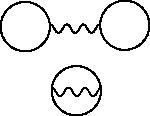 | ||
In quantum field theory, the effective action is a modified expression for the action, which takes into account quantum-mechanical corrections, in the following sense:
Contents
In classical mechanics, the equations of motion can be derived from the action by the principle of stationary action. This is not the case in quantum mechanics, where the amplitudes of all possible motions are added up in a path integral. However, if the action is replaced by the effective action, the equations of motion for the vacuum expectation values of the fields can be derived from the requirement that the effective action be stationary. For example, a field
Furthermore, the effective action can be used instead of the action in the calculation of correlation functions, and then only tree diagrams should be taken into account.
Mathematical details
Everything in the following article also applies to statistical mechanics. However, the signs and factors of i are different in that case.
Given the partition function Z[J] in terms of the source field J, the energy functional is its logarithm.
Some physicists use W instead where W = −E. See sign conventions
In multiple areas of mathematics and information theory, including statistical mechanics, one writes the partition function as
Just as Z is interpreted as the generating functional (aka characteristic function(al)/moment-generating function(al) of the probability distribution function(al) e−S[φ]/Z) of the time ordered VEVs/Schwinger function (aka moments) (see path integral formulation), E (a.k.a. the second characteristic function(al)/cumulant-generating function(al)) is the generator of "connected" time ordered VEVs/connected Schwinger functions (i.e. the cumulants) where connected here is interpreted in the sense of the cluster decomposition theorem which means that these functions approach zero at large spacelike separations, or in approximations using Feynman diagrams, connected components of the graph.
or
in the deWitt notation
Then the n-point correlation function is the sum over all the possible partitions of the fields involved in the product into products of connected correlation functions. To clarify with an example,
Assuming E is a convex functional (which is debatable), the Legendre transformation gives a one-to-one correspondence between the configuration space of all source fields and its dual vector space, the configuration space of all φ fields. If E is not convex, we take the Fenchel conjugate instead. φ here is a classical field and not a quantum field operator.
Slightly out of the usual sign conventions for Legendre transforms, the value
or
is associated to J. This agrees with the time ordered VEV <φ>J. The Legendre transform of E is the effective action (this corresponds to the rate function, which is the Fenchel conjugate of the cumulant-generating function, a common construction in statistics; e.g. the Chernoff bound)
or
where
and
or
There are some caveats, though, the major one being we don't have a true one-to-one correspondence between the dual configuration spaces.
Let us first consider the case without tadpoles, i.e.
But what if we have tadpoles? We can always adjust the source J so that there are no tadpoles, i.e.
One loop approximation
The one-loop approximation to the effective action is
